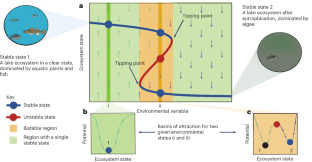临界点的进化转变可促使或防止微生物群落崩溃
IF 13.9
1区 生物学
Q1 ECOLOGY
引用次数: 0
摘要
全球生态系统正在迅速逼近临界点,在这里,微小的变化都可能导致生态的剧烈变化。理论预测,进化可以塑造系统的临界点行为,但缺乏直接的实验支持。在这里,我们研究了进化过程改变这些临界点并保护生态群落免于崩溃的能力。为此,我们将一个由大肠杆菌和面包酵母(Saccharomyces cerevisiae)组成的双物种微生物系统繁殖了 4000 多代,并绘制了共同进化前后的生态稳定性图。我们的研究结果表明,临界点和生态群落的其他几何特性可以通过进化改变微生物群落繁衍生息的条件范围。我们建立了一个数学模型来说明生长率、承载力和对环境变化的抵抗力等参数的进化变化如何影响生态恢复力。我们的研究表明,关键物种的适应可以改变生态群落的临界点,从而有可能促进生态稳定或加速崩溃。本文章由计算机程序翻译,如有差异,请以英文原文为准。


Evolutionary shift of a tipping point can precipitate, or forestall, collapse in a microbial community
Global ecosystems are rapidly approaching tipping points, where minute shifts can lead to drastic ecological changes. Theory predicts that evolution can shape a system’s tipping point behaviour, but direct experimental support is lacking. Here we investigate the power of evolutionary processes to alter these critical thresholds and protect an ecological community from collapse. To do this, we propagate a two-species microbial system composed of Escherichia coli and baker’s yeast, Saccharomyces cerevisiae, for over 4,000 generations, and map ecological stability before and after coevolution. Our results reveal that tipping points—and other geometric properties of ecological communities—can evolve to alter the range of conditions under which our microbial community can flourish. We develop a mathematical model to illustrate how evolutionary changes in parameters such as growth rate, carrying capacity and resistance to environmental change affect ecological resilience. Our study shows that adaptation of key species can shift an ecological community’s tipping point, potentially promoting ecological stability or accelerating collapse. Empirical evidence on how evolution affects the stability of ecological communities is scarce. Here, using two-species microbial assemblages as a model system, the authors show that adaptation can alter the tipping points of an ecological community.
求助全文
通过发布文献求助,成功后即可免费获取论文全文。
去求助
来源期刊

Nature ecology & evolution
Agricultural and Biological Sciences-Ecology, Evolution, Behavior and Systematics
CiteScore
22.20
自引率
2.40%
发文量
282
期刊介绍:
Nature Ecology & Evolution is interested in the full spectrum of ecological and evolutionary biology, encompassing approaches at the molecular, organismal, population, community and ecosystem levels, as well as relevant parts of the social sciences. Nature Ecology & Evolution provides a place where all researchers and policymakers interested in all aspects of life's diversity can come together to learn about the most accomplished and significant advances in the field and to discuss topical issues. An online-only monthly journal, our broad scope ensures that the research published reaches the widest possible audience of scientists.
 求助内容:
求助内容: 应助结果提醒方式:
应助结果提醒方式:


